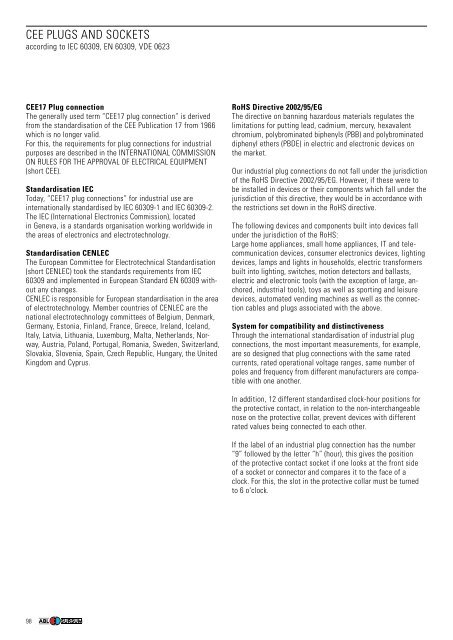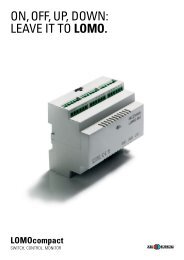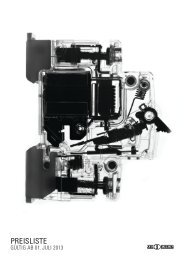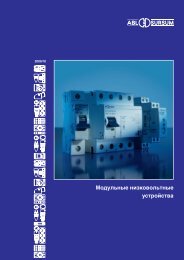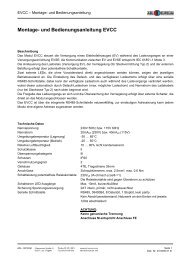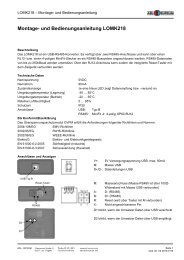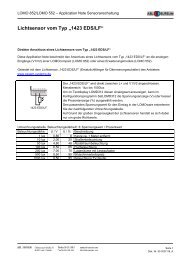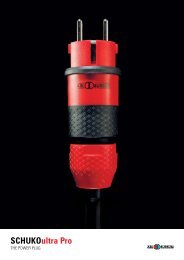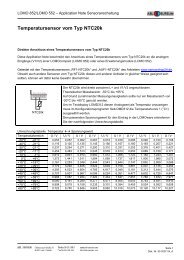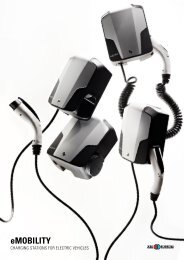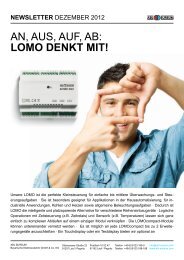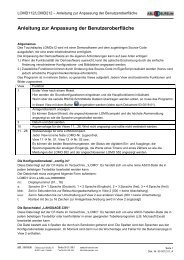DOWNLOAD Low Voltage Devices - ABL Sursum
DOWNLOAD Low Voltage Devices - ABL Sursum
DOWNLOAD Low Voltage Devices - ABL Sursum
Create successful ePaper yourself
Turn your PDF publications into a flip-book with our unique Google optimized e-Paper software.
CEE PLUGS AND SOCKETS<br />
according to IEC 60309, EN 60309, VDE 0623<br />
CEE17 Plug connection<br />
The generally used term “CEE17 plug connection” is derived<br />
from the standardisation of the CEE Publication 17 from 1966<br />
which is no longer valid.<br />
For this, the requirements for plug connections for industrial<br />
purposes are described in the INTERNATIONAL COMMISSION<br />
ON RULES FOR THE APPROVAL OF ELECTRICAL EQUIPMENT<br />
(short CEE).<br />
Standardisation IEC<br />
Today, “CEE17 plug connections” for industrial use are<br />
internationally standardised by IEC 60309-1 and IEC 60309-2.<br />
The IEC (International Electronics Commission), located<br />
in Geneva, is a standards organisation working worldwide in<br />
the areas of electronics and electrotechnology.<br />
Standardisation CENLEC<br />
The European Committee for Electrotechnical Standardisation<br />
(short CENLEC) took the standards requirements from IEC<br />
60309 and implemented in European Standard EN 60309 with -<br />
out any changes.<br />
CENLEC is responsible for European standardisation in the area<br />
of electrotechnology. Member countries of CENLEC are the<br />
na tional electrotechnology committees of Belgium, Denmark,<br />
Germany, Estonia, Finland, France, Greece, Ireland, Iceland,<br />
Italy, Latvia, Lithuania, Luxemburg, Malta, Netherlands, Norway,<br />
Austria, Poland, Portugal, Romania, Sweden, Switzerland,<br />
Slovakia, Slovenia, Spain, Czech Republic, Hungary, the United<br />
Kingdom and Cyprus.<br />
RoHS Directive 2002/95/EG<br />
The directive on banning hazardous materials regulates the<br />
limitations for putting lead, cadmium, mercury, hexavalent<br />
chromium, polybrominated biphenyls (PBB) and polybrominated<br />
diphenyl ethers (PBDE) in electric and electronic devices on<br />
the market.<br />
Our industrial plug connections do not fall under the jurisdiction<br />
of the RoHS Directive 2002/95/EG. However, if these were to<br />
be installed in devices or their components which fall under the<br />
jurisdiction of this directive, they would be in accordance with<br />
the restrictions set down in the RoHS directive.<br />
The following devices and components built into devices fall<br />
under the jurisdiction of the RoHS:<br />
Large home appliances, small home appliances, IT and telecommunication<br />
devices, consumer electronics devices, lighting<br />
devices, lamps and lights in households, electric transformers<br />
built into lighting, switches, motion detectors and ballasts,<br />
electric and electronic tools (with the exception of large, anchored,<br />
industrial tools), toys as well as sporting and leisure<br />
devices, automated vending machines as well as the connection<br />
cables and plugs associated with the above.<br />
System for compatibility and distinctiveness<br />
Through the international standardisation of industrial plug<br />
connections, the most important measurements, for example,<br />
are so designed that plug connections with the same rated<br />
currents, rated operational voltage ranges, same number of<br />
poles and frequency from different manufacturers are compatible<br />
with one another.<br />
In addition, 12 different standardised clock-hour positions for<br />
the protective contact, in relation to the non-interchangeable<br />
nose on the protective collar, prevent devices with different<br />
rated values being connected to each other.<br />
If the label of an industrial plug connection has the number<br />
“9” followed by the letter “h” (hour), this gives the position<br />
of the protective contact socket if one looks at the front side<br />
of a socket or connector and compares it to the face of a<br />
clock. For this, the slot in the protective collar must be turned<br />
to 6 o‘clock.<br />
98


